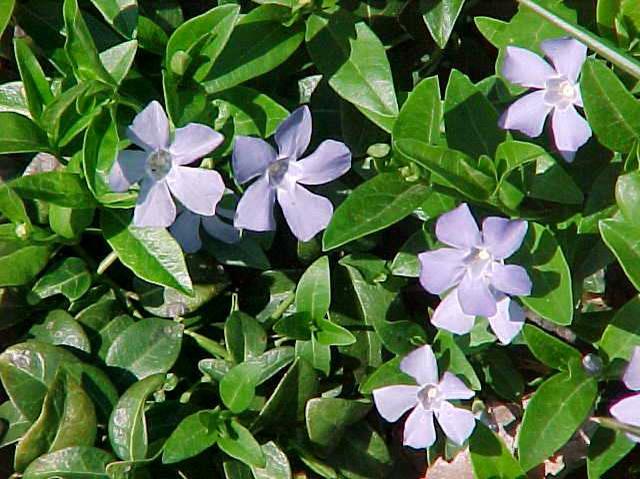Common periwinkle (Vinca minor)
Common periwinkle
Vinca minor commonly know as vinca or periwinkle is one of the most popular and widely used ground covers. Trailing stems with smooth, evergreen leaves (to 5″ long) root at the nodes as they go along the ground and quickly spread to form an attractive ground cover. Tubular, lavender blue, phlox-like flowers (to 1 inch across) appear in the leaf axils in spring and continue to flower intermittently throughout summer into fall. Foliage will mound up to 6″ tall. Also commonly called dwarf periwinkle and creeping myrtle.
Genus name is from Latin meaning to bind or wind around in reference to the long, flexible stems that were used in wreath making.
Specific epithet means smaller. The leaves of Vinca minor are smaller than those of Vinca major.

Easily grown in average, dry to medium, well-drained soil in full sun to part shade. Tolerates close to full shade. Prefers moist, humusy soils in part shade. Plant 8″ apart for quick cover of smaller areas. Plant 12-18″ apart to cover large areas.
| Hardiness zone | 4 - 8 |
| Sun light | Full sun to part shade |
| Water | Dry to medium |
| Maintenance | Medium |
No serious insect problems but vinca stem canker (blight) can damage or kill large patches. Can spread aggressively into adjacent lawns or garden areas.
Versatile ground cover for shady areas. Good cover for bulbs. Effective on slopes or banks to stabilize soils and prevent erosion.
| Common name | Common periwinkle |
| Botanical name | Vinca minor |
| Plant type | Herbaceous perennial |
| Family | Apocynaceae |
| Hardiness zone | 4 - 8 |
| Water | Dry to medium |
| Maintenance | Medium |
| Flower color | Lavender blue |
| Flowering period | May - June |
| Height | 0.25 to 0.50 feet |
| Width | 0.50 to 1.50 feet |